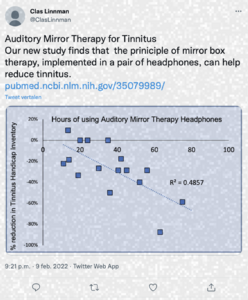- Apr 6, 2020
- 1,032
- Tinnitus Since
- 2016
- Cause of Tinnitus
- 2016: headphones, 2020: worsened thanks to Rammstein
There's some pretty cool stuff happening at the Spaulding Neuroimaging Laboratory in Massachusetts. Dr. Clas Linnman and his team have developed a specific kind of mirror therapy for tinnitus. They have already conducted a pilot study and the results are quite positive to say the least.
The project has recently received financial backing from the Mass General Brigham Hospital, which is one of the most prestigious health care institutions in the US. Thanks to the financial aid, they are planning to conduct a larger, placebo-controlled trial.
Here's a summary of what Auditory Mirror Therapy (AMT) exactly entails:
Auditory Mirror Therapy for Tinnitus -- Clas Linnman, PhD, Spaulding Rehabilitation Network. Current healthcare cost for tinnitus (ringing in the ears) in the U.S. is estimated at $17 billion. About one in ten adults suffer from tinnitus, yet there are no FDA approved drugs or devices. The proposed technology provides a new type of treatment for tinnitus that is non-invasive, affordable, and low risk. This neuromodulatory therapy is based on disruption of multi-sensory integration. Like mirror box therapy for phantom pain, in this therapy, sound at the left ear is transmitted to the right ear canal, and sound at the right ear is transmitted to the left ear canal. Implemented in a wearable pair of headphones, a pilot trial of "auditory mirror therapy" (AMT) indicates that brief use of the headphones significantly and substantially reduced tinnitus. The effects of AMT will be verified in a larger, placebo-controlled study of persons with tinnitus. The technology can be implemented as a separate device, added to current hearing aids, or as a software application for microphone-equipped wireless earbuds, with the potential to help many with tinnitus.
Link:
Mass General Brigham Awards $1 Million to Biotech Breakthroughs
The project has recently received financial backing from the Mass General Brigham Hospital, which is one of the most prestigious health care institutions in the US. Thanks to the financial aid, they are planning to conduct a larger, placebo-controlled trial.
Here's a summary of what Auditory Mirror Therapy (AMT) exactly entails:
Auditory Mirror Therapy for Tinnitus -- Clas Linnman, PhD, Spaulding Rehabilitation Network. Current healthcare cost for tinnitus (ringing in the ears) in the U.S. is estimated at $17 billion. About one in ten adults suffer from tinnitus, yet there are no FDA approved drugs or devices. The proposed technology provides a new type of treatment for tinnitus that is non-invasive, affordable, and low risk. This neuromodulatory therapy is based on disruption of multi-sensory integration. Like mirror box therapy for phantom pain, in this therapy, sound at the left ear is transmitted to the right ear canal, and sound at the right ear is transmitted to the left ear canal. Implemented in a wearable pair of headphones, a pilot trial of "auditory mirror therapy" (AMT) indicates that brief use of the headphones significantly and substantially reduced tinnitus. The effects of AMT will be verified in a larger, placebo-controlled study of persons with tinnitus. The technology can be implemented as a separate device, added to current hearing aids, or as a software application for microphone-equipped wireless earbuds, with the potential to help many with tinnitus.
Link:
Mass General Brigham Awards $1 Million to Biotech Breakthroughs

 Member
Member
